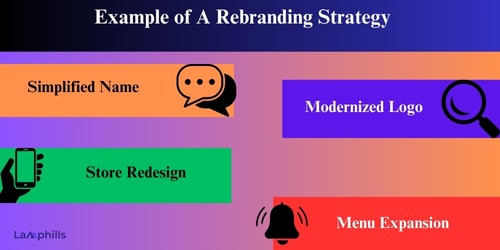Rebranding Campaign identity is a crucial aspect of any business, as it ensures a strong and identifiable brand in the marketplace. Rebranding campaigns are not just about changing logos or color schemes; they require a detailed investigation into the brand’s values and vision. Expert ideas are often incorporated into brainstorming sessions to ensure a unified approach, leading to its original solutions and a stronger brand identity.

Timing and communication are also essential in rebranding campaigns, as changes are implemented gradually to keep the audience informed and maintain trust and enthusiasm. A successful rebranding effort involves defining basic beliefs, creating a message that resolves, and using professional techniques, real-world examples, and practical recommendations to make the rebranding effort a compelling relaunch rather than just a mere design.
Buckle up, because I’ll go deep into how to launch a rebranding campaign, from defining your basic beliefs to creating a message that resonates with professional techniques, real-world examples, and practical recommendations to make your rebranding effort a compelling relaunch rather than a mere design.
Key Point:
- Importance of Brand Identity Brand identity is crucial for any business. It ensures a strong, identifiable presence in the marketplace, setting you apart from competitors and resonating with your audience. Think of it as the personality of your brand that customers connect with and remember.
- Beyond Logos and Colors, Rebranding campaigns are not just about changing logos or color schemes. They require a detailed investigation into the brand’s values and vision. This deep dive ensures that the rebranding aligns with the core essence of the brand, making it authentic and meaningful.
- Incorporating Expert Ideas Successful rebranding campaigns often involve expert ideas during brainstorming sessions. This unified approach leads to original solutions and a stronger brand identity. Experts bring fresh perspectives and industry insights that can transform the brand’s image effectively.
- Timing and Communication Timing and communication are essential in rebranding campaigns. Implementing changes gradually and keeping the audience informed helps maintain trust and enthusiasm. Clear, consistent messaging ensures that customers understand and embrace the new brand identity.
- Comprehensive Strategy A successful rebranding effort involves defining basic beliefs, creating a resonant message, and using professional techniques, real-world examples, and practical recommendations. This approach makes the rebranding effort a compelling relaunch rather than just a mere design change.
How To Launch A Rebranding Campaign?
I remember the first time I launched a rebranding campaign. The excitement and anxiety were palpable. I knew that this wasn’t just about changing a logo or color scheme. It was about transforming the entire perception of the brand. Here’s how I did it, step by step.
#1. Define Your Goals and Objectives
Before diving into any rebranding campaign, I sat down and clearly defined my goals and objectives, which were, What did I want to achieve? Increased market share? A refreshed image? Knowing these targets kept me focused and on track. It also helped in communicating the vision to the team, ensuring everyone was on the same page.
#2. Research Your Market and Audience
After defining my goals and objectives, I buried myself deep in research. I knew that Understanding the market and audience was crucial. I studied competitors, trends, and customer preferences. This research provided valuable insights that shaped the new brand identity. It wasn’t just about what I wanted the brand to be, but what the audience needed it to be. I remember one survey revealing an unexpected customer pain point, which became a central theme in our rebranding efforts.
#3. Develop Your Brand Identity and Positioning
With clear goals and thorough research, I moved on to developing the brand identity and positioning. This involved creating a new logo, choosing colors, and defining the brand’s voice. But it wasn’t just aesthetics. It was about conveying the brand’s essence and values. I worked closely with designers and copywriters, ensuring that every element resonated with our vision. Seeing the first draft of our new logo felt like a milestone, a visual representation of our efforts.
#4. Plan and Execute Your Campaign Strategy and Tactics
Planning and executing the campaign strategy was the next big step. I created a detailed plan outlining every action, from social media posts to press releases. The timing was crucial, so I scheduled the rollout in phases. This allowed us to manage the transition smoothly and address any issues promptly. I remember the day we launched our new website, watching the traffic surge and the positive feedback roll in. It was a moment of validation for all the hard work.
#5. Evaluate and Optimize Your Campaign Performance and Impact
After the launch, evaluating and optimizing the campaign’s performance was essential. I tracked key metrics like engagement, sales, and customer feedback. This data helped in tweaking the strategy to enhance effectiveness. Continuous monitoring ensured that we stayed aligned with our goals. I vividly recall a mid-campaign adjustment that significantly boosted our engagement rates, reinforcing the importance of adaptability.
Download Lamphills Checklist for Rebranding Campaign
What is An Example of A Rebranding Strategy?

Rebranding is when a company changes its image, name, logo, or overall identity to shift public perception. This strategy can help a business stay relevant, appeal to a new audience, or recover from negative press. Here are four top strategies for rebranding, along with examples from major businesses.
#1. Simplified Name
Sometimes, simplifying your brand name is a good strategy for winning public perception. For example, take a look at Dunkin’ Donuts transforming into Dunkin’. By dropping “Donuts” from its name, Dunkin’ emphasized its wide range of beverages and food, not just donuts. This shift helped attract a broader audience interested in coffee and other menu items.
#2. Modernized Logo
Modernized logos are a crucial strategy used in rebranding campaigns. For example, Twitter updated its logo to a cleaner, more modern design. The new look maintains brand recognition while signaling a fresh start.
#3. Store Redesign
Dunkin Donuts revamped their stores to create a more inviting atmosphere, adding digital kiosks and improved seating areas. This made the experience more appealing to a younger, tech-savvy crowd.
#4. Menu Expansion
Dunkin’ also added healthier options and trendy items like cold brew coffee and plant-based sandwiches. This broadened their appeal beyond traditional donut lovers.
READ ALSO: Brand Pitch Email Templates: What Major Companies Use To Land 85% Of Their Clients
How Do You Announce A Rebranding?

Rebranding is an exciting journey. It’s all about reinventing your brand to better align with your goals and audience. But how you announce it can make or break the whole thing. To announce a rebranding effectively, start with a clear and enthusiastic statement about why you’re making the change. Here are some ways or platforms you can announce your rebranding:
#1. Social Media
Tease the transition using cryptic messages, such as a new logo silhouette or color palette change. Allow your eagerness to build! Then, kick off the entire reveal with a boom, such as a splashy film, a series of striking pictures exhibiting your new brand identity, or even a live question-and-answer (Q&A) session with the rebranding team.
#2. Email Listing
Crafting a personalized email listing message explaining the “why” behind the rebranding. Show how it reflects your company’s growth and how it benefits your customers.
#3. Press Releases
Press releases are gold for media coverage. Crafting a compelling one is key, that highlights your new brand story, mission, and vision. Sending it to relevant journalists and publications might just land you a coveted feature!
#4. Speaking of Stories: A Behind-The-scenes
Share the rebranding journey on your blog or social media. This humanizes the process and lets your audience connect with the passion behind the changes of your company’s rebranding.
READ ALSO: Brand Assets: 15 Examples That Will Strengthen Your Brand
What are The Three Types of Rebranding?
Rebranding is a powerful strategy that can breathe new life into a business. There are three main types of rebranding: Brand Refresh, Full Rebrand, and Brand Extension. Each type serves a unique purpose and has its own functions.
#1. Brand Refresh
A brand refresh is like giving your brand a makeover. You update the visual elements, such as the logo, color scheme, and design, to stay current with market trends. This doesn’t change the core identity but gives it a fresh look. For me, refreshing my brand helped me reconnect with my audience. I updated my logo and website design, making it more modern and visually appealing. It led to increased engagement and positive feedback from my clients.
#2. Brand Extension
This is when you expand your brand’s offerings while keeping the core identity intact. Think of it as adding new flavors to your existing ice cream shop. You’re not changing the core business, but you’re giving your audience more reasons to love you. This was the strategy behind my favorite local yoga studio, “Sun Salutations.” They added meditation classes alongside their popular yoga sessions, all under the same brand umbrella. It attracted a new audience seeking a more holistic wellness experience while keeping their existing yoga devotees happy.
#3. Rebrand
A full rebrand involves a complete overhaul of your brand’s identity. This means changing everything from the brand name and logo to the mission, vision, and values. It’s usually done when a company undergoes significant changes or wants to target a new audience. I once did a full rebrand when shifting my business focus from local to international markets. This included a new name, logo, and brand story, which significantly boosted my brand recognition and credibility globally.
READ ALSO: How To Become a Brand Ambassador: A Simple Plan For Regular People
How Do You Write A Rebranding Proposal?
Writing a rebranding proposal involves clear guidelines to ensure a thorough and persuasive presentation. Here’s how I do it:
- Company background: Provide a brief overview of your company’s history, mission, and core values to give context to the rebranding proposal.
- Rebranding project objectives: Clearly state the goals you aim to achieve with the rebranding, such as increased market share or refreshed brand image.
- Rebranding services you need: List specific services required, like logo redesign, brand messaging development, and marketing strategy to execute the rebrand.
- Your target audience is: Define the demographic and psychographic characteristics of the audience you want to reach with your rebranded identity.
- Existing challenges: Identify the key issues your current brand is facing, such as outdated visuals or a lack of market differentiation, which the rebranding will address.
- Project scope: Outline the extent of the rebranding project, including all elements to be redesigned or updated to give a comprehensive view.
- Project timeline: Provide a timeline with key milestones and deadlines to ensure the rebranding project stays on track and is completed on time.
- Budget: Detail the estimated costs associated with the rebranding, covering all aspects from design to implementation for transparency.
- Proposal timeline: Specify the deadline for proposal submissions and any important dates for meetings or presentations to keep the process organized.
- Criteria for selection: Explain the criteria you will use to evaluate proposals, such as creativity, experience, and alignment with project objectives for clarity.
- Contact information: Include the primary contact person’s details for any questions or further information to facilitate smooth communication.
Final Words
Executing a successful rebranding campaign requires a strategic approach, creativity, and a deep understanding of your audience. Focus on clear communication, consistent messaging, and genuine engagement with your customers. Remember, a rebranding campaign is not just about a new logo or tagline but about reshaping perceptions and strengthening your brand’s identity.
I remember working with a local café that struggled to attract customers despite having great products. We embarked on a rebranding campaign, starting with a fresh, modern logo and revamped interior. We emphasized their use of locally sourced ingredients and crafted a story that resonated with the community. The rebranding campaign also included social media outreach, where we shared behind-the-scenes stories and customer testimonials.
One day, a customer told me how much they appreciated the new atmosphere and the café’s commitment to local produce. Seeing our hard work pay off and the café bustling with happy customers felt rewarding. This experience reinforced my belief in the power of a well-executed rebranding campaign. It’s about connecting with your audience on a deeper level and staying true to your core values. So, dive into your rebranding campaign with confidence, and watch your brand transform and thrive.
Related Articles
The Power of Brand Monitoring Software: Unlocking Consumer Insights
Brand Journalism: Everything You Should Know About
How to Protect Your Brand Online & Offline (Expert Tips)






